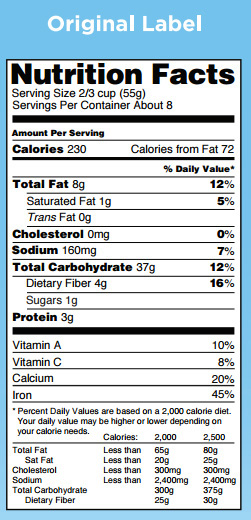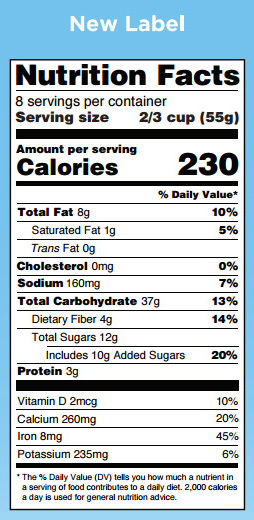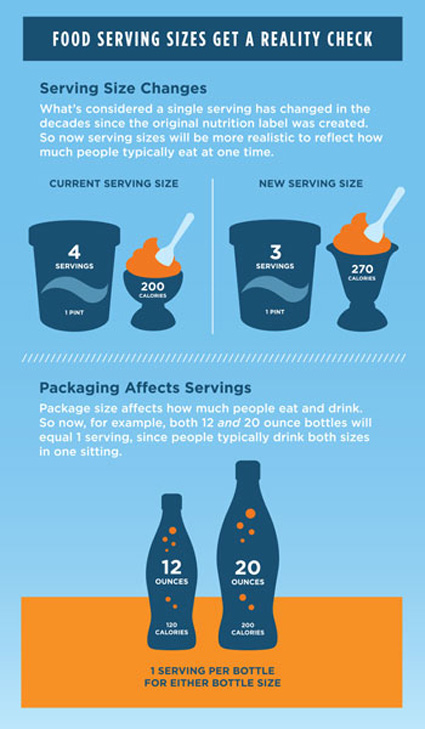The NEW Nutrition Facts Label
For years companies claimed trans fats weren't that big of a problem. Then they said they shouldn't have to list it on their labels because consumers didn't care. But after years of fighting and foot-dragging, the change became a requirement. Rather than reveal they were selling trans fat poison, hundreds of products were updated. The majority of companies took trans fats out and made their products healthier.
This new label will inspire another round of similar updates.


Food Label Images courtesy of the Food and Drug Administration.
The first and most obvious change is the size of the calories. On the new label, it's significantly larger and virtually impossible to miss.
The "serving size" is also much more prominent and updated. Since 1993, serving sizes were based on what people SHOULD be eating. For example, a serving of ice cream was set at 1/2 a cup. Under the new regulation that's changing to 2/3 of a cup. A serving of soda is increasing from 8 to 12 ounces. We're eating more and the labels need to reflect reality.
Package size also makes a difference and the rules on that are changing as well. A 20-ounce soda or a 15 ounce can of soup, will now be required to list everything in the container as a single serving. It only makes sense, since that's what people typically consume in a single sitting.
There will also now be "dual column" labels. Some products are sold in containers that hold more than a single serving, but the food is often consumed in one sitting. A pint of ice cream is an example. Under the new regulations, you'll see that there are three servings in a container, but you'll also see a row of how many calories you'll get if you finish off the entire pint.

Image courtesy the Food and Drug Administration.
The change that's most upsetting to many food companies is how sugar is listed. On the new label, there's a line beneath total sugars. It tells you exactly how much sugar was added to a product by the manufacturer. The label also reveals, for the very first time, the "% Daily Value".
What that means is that when you buy a 12-ounce bottle of Coca-Cola, you will see that it includes 100% of your recommended daily value of sugar. That's right, one soda has all the sugar you're allowed in an entire day, and now the labels will finally reveal that ugly little truth.
The Sugar Association, an industry trade group said, "We are concerned that the ruling sets a dangerous precedent that is not grounded in science, and could actually deter us from our shared goal of a healthier America." I'm not sure how telling people the truth about all the excess sugar they're eating is bad, but I don't think the Sugar Association is in the business of helping people reduce the sugar in their diet.
Now for the bad news. The new labels aren't required until July 26, 2018. Companies with annual sales of less than $10 million get an extra year to comply, so that means 2019.
Think for a minute about all that food in your local supermarket. Most of it's going to be sold and replaced in as little as seven to thirty days. What you're going to see is that healthy foods, the ones that want to show all the good things they contain, will switch to the new labels as quickly as possible. It's the foods with something to hide that will resist.
As the changeover progresses, a simple way to spot unhealthy foods will be to look for the old labels. If you still see them, that may be a company that's trying to hide something.
They said WHAT?
Here's one of those quotes about the new label that made us say WHAT? The Sugar Association said, "implementation of this regulation would be excessively burdensome and costly for the entire food industry and ultimately the consuming public...”
That's pretty funny. Changing the labels to expose how much sugar the food companies are shoving in their products is "excessively burdensome"? Yet manufacturers routinely change and update labels to sell more products and THAT isn't considered excessively burdensome.
A nice little break as Brian Regal talks about food and labels.
Call for a FREE Consultation (305) 296-3434
CAUTION: Check with your doctor before
beginning any diet or exercise program.
6/12/2016


